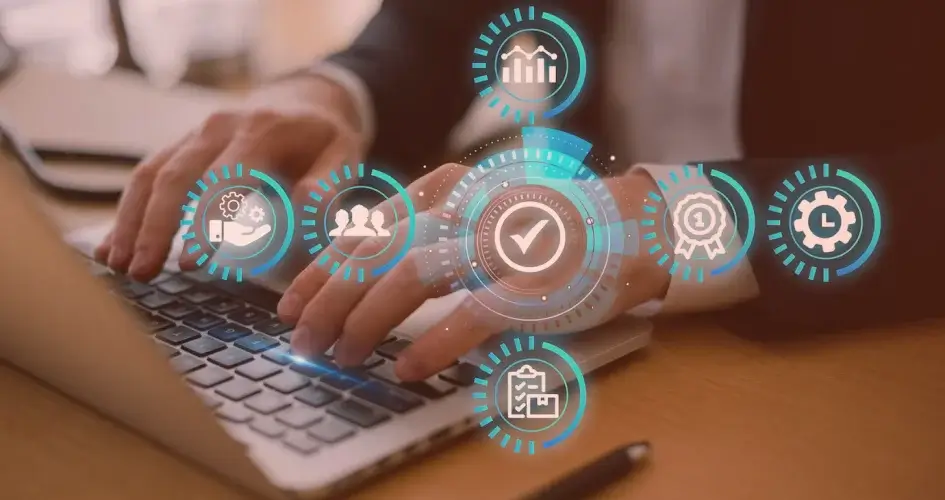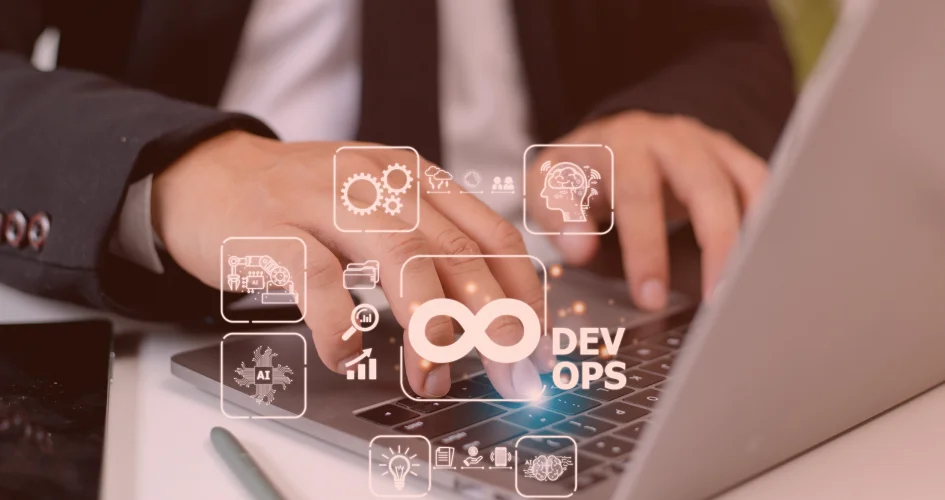Starting the software development journey requires a keen awareness of the latest technologies.
Doing so will not only help you develop innovative software but also ensure that your projects meet current standards and anticipate future demands.
This blog can be your compass in understanding the top trending technologies in software development, pointing you toward success in developing up-to-date, efficient, and user-centric applications.
Let’s dive in!
1. Low-Code and No-Code Development Platforms
Creating software can be a lengthy and complicated process.
The low-code and no-code development platforms are the perfect answer.
Low-code platforms streamline traditional coding by providing visual interfaces, pre-built user interface (UI) components, and integrations.
Meanwhile, no-code platforms eliminate the need for coding altogether.
These platforms help reduce the software development timeline significantly, enabling developers to quickly turn an idea into reality.
Beyond speed, the platforms can also open up software development to more people, making it more inclusive and promoting collaboration between technical and non-technical stakeholders.
As stated in Gartner’s research, more than half of low-code users will be non-technical by 2025 thanks to the platforms’ simplicity and lower learning curve than traditional tools.
Projects ideal for using low-code or no-code development platforms include:
- Developing product catalogs with their intuitive drag-and-drop interface
- Building simple minimum viable products (MVP) to gather customer feedback fast about a product without spending a fortune.
- Enhancing customer experience by automating workflows and letting them interact with user-friendly systems to perform simple tasks.
- Creating data analytics solutions to take less time to gather insights and make decisions.
However, challenges include limitations in customization and scalability, as well as concerns about security and governance.
2. DevOps and Continuous Integration/Continuous Deployment (CI/CD)
DevOps has revolutionized the software development landscape.
It combines traditionally siloed development and operations teams.
Central to the DevOps model is the implementation of Continuous Integration and Continuous Deployment (CI/CD) pipelines.
These automate the software delivery process, allowing developers to seamlessly integrate code changes and deploy applications swiftly.
Automating testing, building, and deployment, CI/CD pipelines help:
- Enhance efficiency
- Reduce errors
- Provide a reliable mechanism
As one of the beneficial software development technologies, no wonder many huge brands have used DevOps in their software.
Automating deployment processes, Netflix could release new features and updates continuously.
It also employs a unique tool named Simian Army which automatically identifies and resolves system failures.
Meanwhile, Etsy, the eCommerce platform for handmade and vintage goods, applied CI/CD pipelines to streamline the release process.
This approach notably reduced the time taken to deploy new code, allowing the development teams to respond rapidly to market changes and customer feedback.
Another big brand that has used DevOps is Amazon.
The giant eCommerce and cloud computing company applied DevOps to improve infrastructure management.
Automation tools like AWS CloudFormation and AWS Elastic Beanstalk simplified resource provisioning and scaling, leading to cost savings and increased operational efficiency while ensuring its service availability.
3. Artificial Intelligence (AI) and Machine Learning (ML)
Today, artificial intelligence (AI) and machine learning (ML) have reshaped industries globally.
It will even grow more significantly to half a trillion dollars by 2024.
These latest technologies power recommendation systems, natural language processing, and image recognition, enhancing the overall software capabilities.
Integrating AI and ML models enables applications to learn and adapt by predicting user preferences, automating responses, or improving task automation.
In the software development strategy, developers can use AI and ML in several stages.
- Prototyping: AI helps create wireframes, mockups, illustrations, and texts seamlessly, which you can integrate into design software like Figma.
- Debugging: Implement the AI technology to automatically identify software issues by analyzing code patterns, data flow, and error logs.
- Code explanation and refactoring: AI-driven code refactors helps developers of all levels understand how code works across programming languages and find any bugs or vulnerabilities hidden within it.
- Predictive analysis: AI-based predictive analytics tools will use historical data, machine learning algorithms, and statistical models to forecast project outcomes, estimate resource requirements, and analyze potential risks.
- Automated testing: Analyze code, identify potential vulnerabilities, and simulate various test scenarios quickly using AI, saving time and resources in your software development life cycle.
- Documentation: AI systems can automatically extract relevant information, so you can quickly generate descriptive documentation and contextual explanations for code snippets, functions, and modules.
4. Augmented Reality (AR) and Virtual Reality (VR)
Imagine using your phone or a special headset to see digital items mixed with the real world or being in a whole new world that feels real.
That’s what augmented reality (AR) and virtual reality (VR) do to our lives.
AR overlays digital information onto the real world, while VR brings users into entirely virtual spaces.
Both trending technologies break traditional boundaries, offering users high levels of engagement and interaction.
The practical applications of AR and VR span across diverse industries.
In gaming, for example, these technologies bring real-time integration of the virtual game elements with the player’s physical environment.
Meanwhile, the healthcare industry benefits from AR in medical training and surgery assistance.
As the demand for AR and VR experiences continues to rise, developers play a pivotal role in meeting this demand.
From virtual product try-ons in e-commerce to virtual tours for real estate, businesses are increasingly integrating AR and VR into their offerings.
A popular example comes from IKEA.
The company uses AR to let customers preview how furniture looks in their own rooms using smartphones before they buy.
5. Progressive Web Apps (PWAs) and Cross-Platform Development
Progressive Web Apps (PWAs) are one of the top trending technologies that has reshaped the way we interact with the web.
One of the most powerful benefits of PWAs is their capability to work seamlessly across platforms and devices.
Users can access your software on a desktop, smartphone, or tablet, and PWAs will adapt to the screen size and device capabilities, delivering a consistent and user-friendly experience as well as boosting conversions.
PWAs also make the app more discoverable as people don’t need to download it via an app store, making them an attractive option for businesses seeking broader user accessibility.
Moreover, PWAs can deliver an offline operation.
This ability provides a good user experience even when the device doesn’t have network connectivity.
The offline model works thanks to the use of Service Worker, as developers implement caching.
Meanwhile, cross-platform development frameworks enable developers to write code that works on multiple platforms including Android and iOS.
This method will help reduce the need for separate codebases and ultimately spend less time in the software development process.
6. Containers and Microservices Architecture
Containers refer to a lightweight and efficient method for apps to move between environments and run independently.
A container object includes everything required to run the application, including code, runtime, system tools, libraries, and dependencies, except the shared operating system on the server.
There are two types of containers:
- Stateless containers – This type of container doesn’t store data, so it may use limited storage. However, anything stored is lost when the container is complete.
- Stateful containers – You require storage to run these containers, but they usually don’t share databases with other containers.
On the other hand, microservices are an architectural design for creating a distributed application.
It breaks an app into independent and individually deployable services.
This architecture enables each service to scale or update without disrupting other services in the application, which brings the following benefits:
- Allowing more scalability and saving resources as developers make only the necessary components.
- Avoiding the central database’s bottlenecks as a certain part can still function, although another service goes down.
- Creating more independence because small teams of developers can work more collaboratively than large teams.
7. Blockchain Technology
Blockchain technology is a decentralized and distributed ledger system recording transactions across a network of computers.
Each transaction is grouped into a block and linked in a chain, creating a secure and tamper-resistant record.
It was part of Bitcoin to assist safe financial services, but its impact now extends far beyond the cryptocurrency world.
Examples include smart contracts and decentralized applications (DApps).
Several industry cases to use one of these latest technologies are:
- Insurance: Blockchain allows insurance teams to put off invalid claims because it can reject fake ones.
- Cybersecurity: The technology guarantees a low score for cyber attacks, creating a safe environment to make payments.
- Government applications: Blockchain can cover records, voting, and identity management.
While the promise of blockchain is solid, integrating it into mainstream software development can cause challenges.
Scalability, interoperability, and energy consumption are key concerns.
Scalability issues may arise as blockchain networks grow, potentially hindering transaction speed.
Making sure interoperability between different blockchains and existing systems is also complex.
Moreover, the energy-intensive consensus mechanisms, like Proof of Work, raise environmental considerations.
If you plan to integrate blockchain into mainstream software development, ensure that you’ve considered regulatory, legal, and governance aspects.
8. 5G Technology
With its ultra-fast speeds, low latency, and increased network capacity, 5G allows you to do activities on your phone or computer at lightning speed.
Therefore, developers can now experiment with richer multimedia experiences and enhance the user experience using real-time features like augmented reality (AR) and virtual reality (VR).
The robust infrastructure of 5G can facilitate the integration of Internet of Things (IoT) devices and edge computing, which can be implemented in various areas like smart cities and homes as well as healthcare.
While the potential is vast, developers may face challenges in adapting to 5G, including:
- Ensuring security
- Addressing privacy concerns
- Optimizing applications for varying network conditions
In fact, 5G technology isn’t available in all parts of the world, even in developed countries like the United States.
In 2023, only 503 cities in the country support 5G although the chart increased compared to the previous year.
9. Sustainable Software Development
The world increasingly focuses on environmental consciousness, making developers recognize their role in building a greener future and consider the environmental impact of their code.
Sustainable software development usually begins with efficient coding practices.
Clean, optimized code helps minimize resource consumption, enhancing the software performance while also reducing the energy required for execution.
Besides green coding methods, developers can apply energy-efficient infrastructure to make their software more environmentally friendly.
One way is to adopt serverless computing to optimize resource usage and lower the carbon footprint of the digital ecosystem.
Minimizing digital waste is also a key aspect of sustainable software development.
Focus on creating applications that use fewer resources, reducing unnecessary data storage and transmission while saving energy.
10. Internet of Behavior
The Internet of Behavior (IoB) redefines how applications interact with users and process data.
IoB analyzes online activities, bringing behavioral data to deliver more personalized software and improve user experiences.
Understanding user behavior through data collection and analysis includes tracking how users interact with applications, websites, and devices.
Some personal data like social media habits and commercial transactions can also be tracked down.
As IoB becomes integral to software development, ethical considerations come to the forefront.
Balancing the benefits of personalized experiences with user privacy and data security is crucial.
Developers must implement strong measures to ensure responsible data handling and transparent communication about data usage to potential users.
Conclusion
As the software development world evolves with the latest technologies, embracing them isn’t just a trend; it’s a strategic imperative to bring more innovation and gain a competitive edge.
From the transformative AI and ML to the seamless experiences offered by PWAs and the importance of sustainable development, the possibilities are immense.
Stay informed, embrace innovation, and use the best practices for software development outlined here to ensure your projects are not only current but well-positioned for the future.
Ready to start your journey of implementing the latest technologies in software development on your projects?
Our expert teams and advanced tools are here to turn your ideas into reality.
Join Intelivita in shaping the future of software development!





